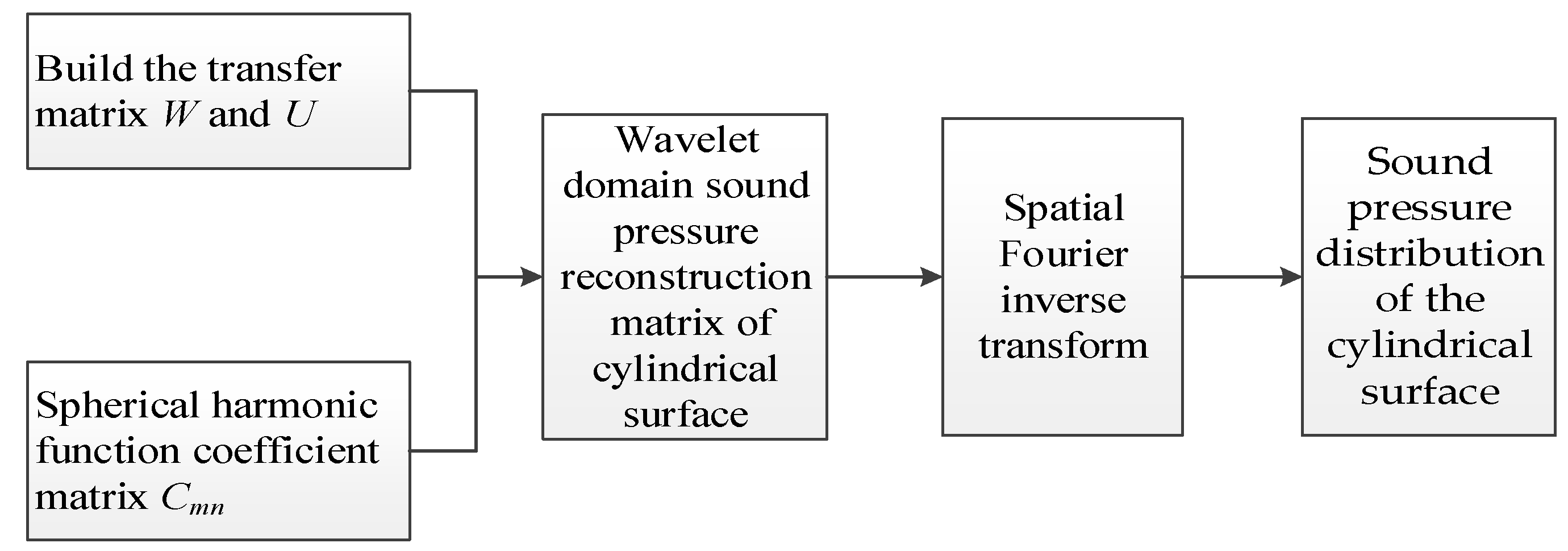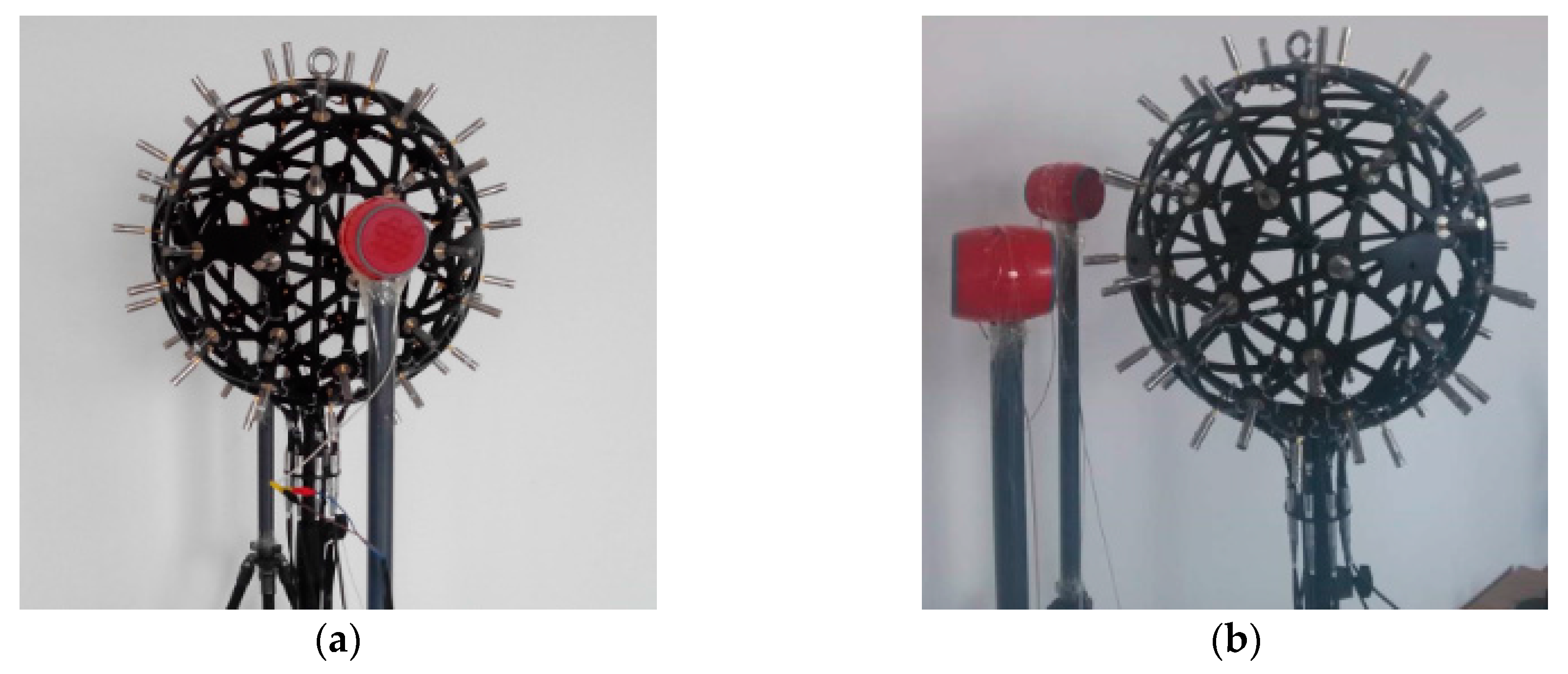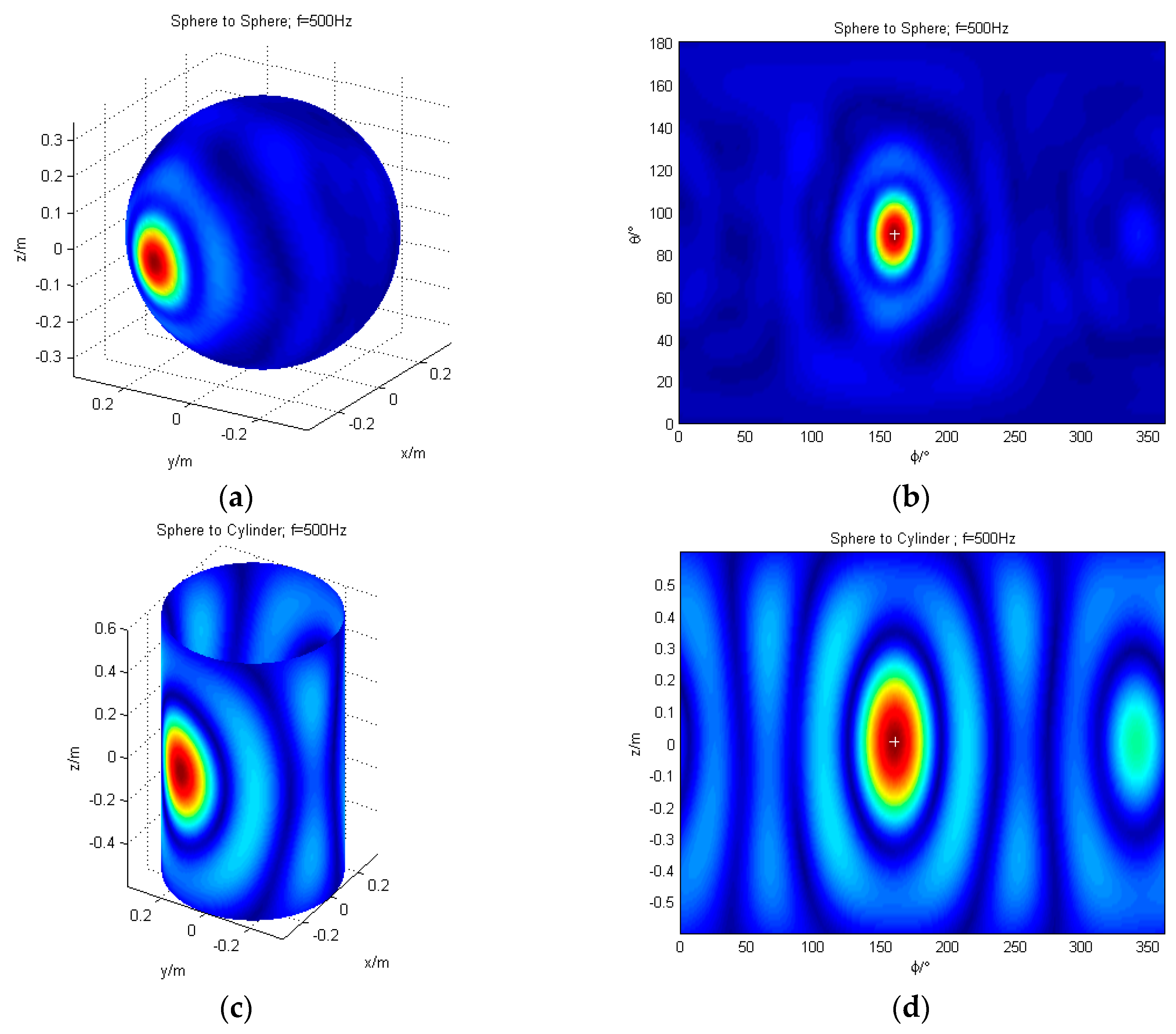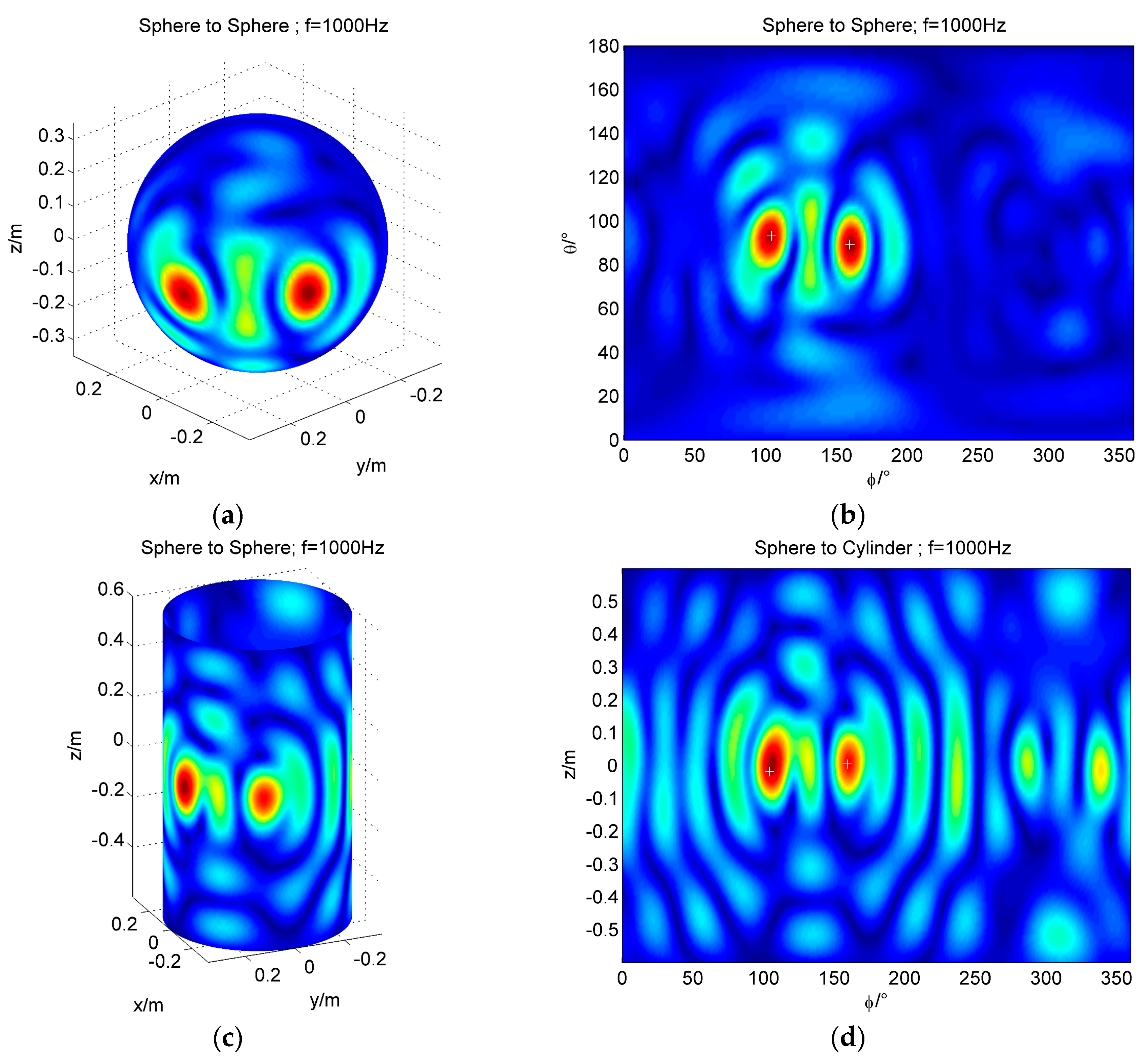Sound Source Localization Using Non-Conformal Surface Sound Field Transformation Based on Spherical Harmonic Wave Decomposition
Abstract
:1. Introduction
2. Materials and Methods
2.1. Data Model of Spherical Array
2.2. Spherical Harmonic Wave Decomposition
2.3. Transfer Matrix and Sound Pressure Field Reconstruction
3. Results
3.1. Simulation Result
3.1.1. Single Sound Source Localization Simulation
3.1.2. Two Sound Sources Localization Simulation
3.2. Experiment Result
3.2.1. Single Sound Source Localization Experiment
3.2.2. Two Sound Sources Localization Experiment
4. Discussion
5. Conclusions
Acknowledgments
Author Contributions
Conflicts of Interest
Appendix A
References
- Meyer, J.; Elko, G. A highly scalable spherical microphone array based on an orthonormal decomposition of the soundfield. In Proceedings of the IEEE International Conference on Acoustics, Speech and Signal Processing, Orlando, FL, USA, 13–17 May 2002; Volume 2, pp. 1781–1784. [Google Scholar]
- Maynard, J.D.; Williams, E.G.; Lee, Y. Nearfield acoustic holography I. Theory of generalized holography and the development of NAH. J. Acoust. Soc. Am. 1985, 78, 1395–1413. [Google Scholar] [CrossRef]
- Lee, J.C. Spherical acoustical holography of low frequency noise sources. Appl. Acoust. 1996, 48, 85–95. [Google Scholar] [CrossRef]
- Song, Y.; Lu, H.; Jin, J. Single microphone array signal space resampling method of acoustic separation. Acta Acust. 2014, 19, 195–204. [Google Scholar]
- Yu, F.; Chen, J.; Zhou, G.; Chen, X. Noise source identification of near-field acoustical holography method and numerical simulation analysis. J. Vib. Eng. 2003, 3, 85–89. [Google Scholar]
- Veronesi, W.A.; Maynard, J.D. Digital holography reconstruction of sources with arbitrarily shaped surfaces. J. Acoust. Soc. Am. 1989, 85, 588–598. [Google Scholar] [CrossRef]
- Bai, M.R. Application of BEM (boundary element method)-based acoustic holography to radiation analysis of sound sources with arbitrarily shaped geometries. J. Acoust. Soc. Am. 1992, 92, 533–549. [Google Scholar] [CrossRef]
- Kim, B.K.; Ih, J.G. On the reconstruction of the vibro-acoustic field over the surface enclosing an interior space using the boundary element method. J. Acoust. Soc. Am. 1996, 105, 3003–3016. [Google Scholar] [CrossRef]
- Bi, C.; Chen, X.; Chen, J. Orthogonal spherical wave source boundary point method and its application to acoustic holography. Chin. Sci. Bull. 2004, 49, 1322–1331. [Google Scholar] [CrossRef]
- Bi, C.; Chen, X.; Zhou, R. Comparison study on spherical wave superposition method and spherical wave source boundary point method for realizing nearfield acoustic holography. Chin. Sci. Bull. 2005, 50, 512–523. [Google Scholar] [CrossRef]
- Balmages, I.; Rafaely, B. Open-Sphere Designs for Spherical Microphone Arrays. IEEE Trans. Audio Speech Lang. Proccess. 2007, 15, 727–732. [Google Scholar] [CrossRef]









| f/Hz | Sphere to Sphere | Sphere to Cylinder | ||||
|---|---|---|---|---|---|---|
| LD in the φ-Direction | LD in the θ-Direction | Localization Accuracy | LD in the φ-Direction | LD in the z-Direction | Localization Accuracy | |
| 125 | 0.00° | 0.00° | 21.50° | 0.00° | 0.01 m | 75.48° |
| 200 | 0.00° | 0.00° | 21.39° | 0.00° | 0.01 m | 71.92° |
| 315 | 0.00° | 0.00° | 21.21° | 0.00° | 0.00 m | 50.45° |
| 500 | 0.00° | 0.00° | 20.89° | 0.00° | 0.00 m | 37.08° |
| 800 | 0.00° | 0.00° | 18.92° | 1.00° | 0.00 m | 27.14° |
| 1000 | 0.00° | 0.00° | 18.30° | 0.00° | 0.00 m | 20.12° |
| 1500 | 0.00° | 0.00° | 21.12° | 0.00° | 0.00 m | 21.14° |
| f/Hz | Sphere to Sphere | Sphere to Cylinder | ||||
|---|---|---|---|---|---|---|
| LD in the φ-Direction | LD in the θ-Direction | Localization Accuracy | LD in the φ-Direction | LD in the z-Direction | Localization Accuracy | |
| 300 | 0.00° | 0.00° | 21.33° | 1.00° | 0.00 m | 43.20° |
| 400 | 0.00° | 0.00° | 21.16° | 2.00° | 0.00 m | 41.35° |
| 500 | 0.00° | 0.00° | 20.67° | −1.00° | 0.00 m | 31.97° |
| 600 | 0.00° | 0.00° | 20.67° | 0.00° | 0.01 m | 30.79° |
| 700 | 0.00° | 0.00° | 20.08° | 0.00° | 0.01 m | 24.57° |
| 900 | 0.00° | 2.00° | 19.20° | 1.00° | 0.01 m | 21.37° |
| 1000 | 0.00° | 2.00° | 18.41° | −1.00° | 0.01 m | 17.42° |
© 2017 by the authors. Licensee MDPI, Basel, Switzerland. This article is an open access article distributed under the terms and conditions of the Creative Commons Attribution (CC BY) license (http://creativecommons.org/licenses/by/4.0/).
Share and Cite
Zhang, L.; Ding, D.; Yang, D.; Wang, J.; Shi, J. Sound Source Localization Using Non-Conformal Surface Sound Field Transformation Based on Spherical Harmonic Wave Decomposition. Sensors 2017, 17, 1087. https://doi.org/10.3390/s17051087
Zhang L, Ding D, Yang D, Wang J, Shi J. Sound Source Localization Using Non-Conformal Surface Sound Field Transformation Based on Spherical Harmonic Wave Decomposition. Sensors. 2017; 17(5):1087. https://doi.org/10.3390/s17051087
Chicago/Turabian StyleZhang, Lanyue, Dandan Ding, Desen Yang, Jia Wang, and Jie Shi. 2017. "Sound Source Localization Using Non-Conformal Surface Sound Field Transformation Based on Spherical Harmonic Wave Decomposition" Sensors 17, no. 5: 1087. https://doi.org/10.3390/s17051087





